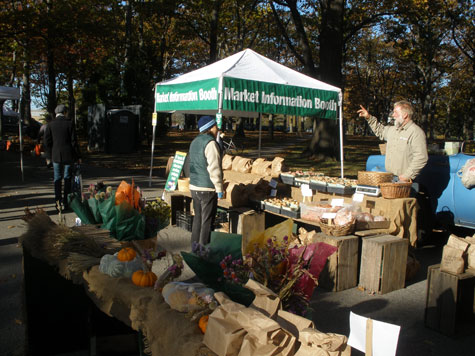
SPREAD THE WORD The Portland Farmers’ Market takes debit and credit cards, as well as food stamps. |
Even on a chilly Saturday morning in November, there's a steady stream of people weaving through the nearly two-dozen farm stands lined up in Deering Oaks Park. While there are certainly fewer baby strollers and bright yellow wagons to contend with this time of year, the foot traffic typically remains high through early December, when the market moves inside to the Maine Irish Heritage Center on the corner of State and Gray streets.
It's been an exceptional summer for many local farmers. "I think this was our best season ever," says Chris Cavendish of Fishbowl Farm in Bowdoinham, who has been selling his produce at the Portland Farmers' Market for eight years. Despite choosing to plant less this year, Cavendish harvested as much, if not slightly more, than in year's past. However, his success depends on more than actual yield — it comes from having a dependable outlet to sell his produce. "Portland always amazes me with the large number of people who are dedicated to coming out, no matter the weather," he says. "I'm confident I'll have a good market day, even if it's a rainy one."
The farmers' market has undergone some serious maturation in the last year, and one that will hopefully continue to reach more people. There's nothing young about the event — it dates back to 1768 — but in the last year, farmers have become more organized, with the creation of the Portland Farmers' Market Association. One of the association's first acts was to add convenience to shopping at the market, and reach people who may not have been able to buy from local farmers.
On July 30, the association started accepting debit and credit cards as well as SNAP (food stamp) cards in exchange for tokens that are used as currency to buy goods from farmers. Jaime Berhanu of Lalibela Farm in Bowdoinham is the secretary of the association and helped get the program up and running. With the support of Cultivating Community, which purchased the wireless card reader for the association, and the city of Portland, farmers can now easily accept food-stamp dollars.
The program has been received with general enthusiasm from most farmers. "I definitely think, all in all, it has brought additional money to the farmers and not just shifted money around," says Cavendish. During the three-month pilot program, Berhanu estimates that the market processed more food-stamp dollars than it did all of last year.
And, if the folks from Cultivating Community have it their way, SNAP and WIC recipients could soon have double the incentive to shop at the market. Through a grant program, the organization would be able to double recipients' benefit dollars, so for every dollar spent at the market, recipients would receive a matching-dollar voucher. "That allows us to literally double the amount of produce that recipients can take home," says Stephanie Aquilina of Cultivating Community. "And farmers will still receive 100 percent of the money spent."
More people with more money is good news for farmers, but growth often comes with challenges. This summer there was increasing controversy regarding the number of artists and crafters selling their wares at the market. "Most farmers are supportive of artists and crafters, but the issue is parking," says Berhanu. "On some summer days, there were 40 or 50 artists set up and that's a lot of parking spots that don't get turned around." She says the association will work with the city to find a solution that ensures customers have a great market experience so they keep coming back, rain or shine.
Leischen Stelter can be reached at leischen@gmail.com.